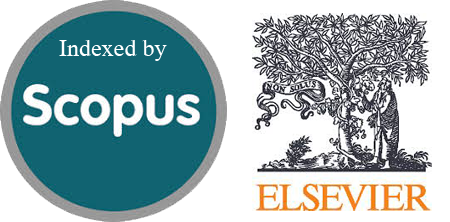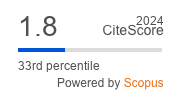Sybil Attack Prediction on Vehicle Network Using Deep Learning
Abstract
Vehicular Ad Hoc Network (VANET) or vehicle network is a technology developed for autonomous vehicles in Intelligent Transportation Systems (ITS). The communication system of VANET is using a wireless network that is potentially being attacked. The Sybil attack is one of the attacks that occur by broadcasting spurious information to the nodes in the network and could cause a crippled network. The Sybil strikes the network by camouflaging themselves as a node and providing false information to nearby nodes. This study is conducted to predict the Sybil attack by analyzing the attack pattern using a deep learning algorithm. The variables exerted in this research are time, location, and traffic density. By implementing a deep learning algorithm enacting the Sybil attack pattern and combining several variables, such as time, position, and traffic density, it reaches 94% of detected Sybil attacks.
Downloads
References
D. A. Ardiansyah, R. Primananda, and A. Bhawiyuga, “Analisis Kinerja Protokol Routing Ad Hoc on Demand Distance Vector (AODV) pada Jaringan Vehicular Ad Hoc Network (VANET) Berdasarkan Variasi Model Jalan”, Jurnal Pengembangan Teknologi Informasi dan Ilmu Komputer, vol. 3, no. 2, pp. 2001-2009.
B. N. Levine, C. Shields, and N. B. Margolin, “A Survey of Solutions to the Sybil Attack”, University of Massachusetts Amherst, MA, 2006.
N. Balachandran, and S. Sanyal, “A review of techniques to mitigate sybil attacks,” International Journal of Advanced Networking and Applications, vol. 4, pp. 1–6, 2012.
R. Hadiwiriyanto, P. H. Trisnawan, and K. Amron, “Implementasi Protokol Geographic Source Routing (GSR) Pada Vehicular Ad-Hoc Network (VANET) untuk Komunikasi Kendaraan Dengan Road Side Unit (RSU)”, Jurnal Pengembangan Teknologi Informasi dan Ilmu Komputer, vol. 2, no. 12, pp. 7000-7016, 2018.
M. Kabbur, V. A. Kumar, “MAR_Sybil: Cooperative RSU Based Detection and Prevention of Sybil Attacks in Routing Process of VANET”, in Journal Physic: Conference Series, vol. 1427, no. 1, IOP Publishing, 2020.
R. Anisia, R. Munadi, and R. M. Negara, “Analisis Performansi Routing Protocol OLSR Dan AOMDV Pada Vehicular Ad Hoc Network (VANET)”, Jurnal Nasional Teknik Elektro, vol. 5, no. 1, pp. 87-97, 2016.
D. Kumari, K. Singh, and M. Manjul, “Performance evaluation of sybil attack in cyber physical system”, Procedia Computer Science, vol. 167, pp. 1013-1027, 2020. doi: 10.1016/j.procs.2020.03.401.
Z. Trifa, and M. Khemakhem, “Sybil nodes as a mitigation strategy against sybil attack”, Procedia Computer Science, vol. 32, pp. 1135-1140, 2014. doi: 10.1016/j.procs.2014.05.544.
Q. Tang, and J. Wang, “A secure positioning algorithm against Sybil attack in wireless sensor networks based on number allocating”, in 2017 IEEE 17th International Conference on Communication Technology (ICCT), pp. 932-936, 2017. doi: 10.1109/ICCT.2017.8359771.
S. Hao, Y. Zhou, and Y. Guo, “A brief survey on semantic segmentation with deep learning”, Neurocomputing, vol. 406, pp.302-321, 2020. doi: 10.1016/j.neucom.2019.11.118.
M. Khalil and M. A. Azer, "Sybil attack prevention through identity symmetric scheme in vehicular ad-hoc networks," in 2018 Wireless Days (WD), pp. 184-186, 2018. doi: 10.1109/WD.2018.8361717.
S. Moradi, and M. Alavi, “A distributed method based on mobile agent to detect Sybil attacks in wireless sensor networks”, in wireless sensor networks. In 2016 Eighth international conference on information and knowledge technology (IKT), pp. 276-280, 2016. IEEE. doi: 10.1109/IKT.2016.7777753.
R.M. Cichy, and D. Kaiser, “Deep Neural Networks as Scientific Models”, Trends in Cognitive Sciences, vo
A. Singh, and P. Sharma, “A novel mechanism for detecting DOS attack in VANET using Enhanced Attacked Packet Detection Algorithm (EAPDA)”, in 2015 2nd international conference on recent advances in engineering & computational sciences (RAECS), pp. 1-5, 2015. doi: 10.1109/RAECS.2015.7453358.
Copyright (c) 2022 Jurnal RESTI (Rekayasa Sistem dan Teknologi Informasi)

This work is licensed under a Creative Commons Attribution 4.0 International License.
Copyright in each article belongs to the author
- The author acknowledges that the RESTI Journal (System Engineering and Information Technology) is the first publisher to publish with a license Creative Commons Attribution 4.0 International License.
- Authors can enter writing separately, arrange the non-exclusive distribution of manuscripts that have been published in this journal into other versions (eg sent to the author's institutional repository, publication in a book, etc.), by acknowledging that the manuscript has been published for the first time in the RESTI (Rekayasa Sistem dan Teknologi Informasi) journal ;








